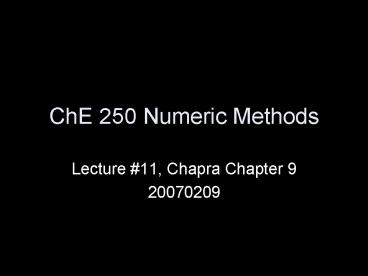ChE 250 Numeric Methods - PowerPoint PPT Presentation
Title:
ChE 250 Numeric Methods
Description:
Systems of linear equations. Determinates, Cramer's Rule. Calculate with Matlab/Scilab ... Using matrix notation our previous equation reduces to a linear set. ... – PowerPoint PPT presentation
Number of Views:93
Avg rating:3.0/5.0
Title: ChE 250 Numeric Methods
1
ChE 250 Numeric Methods
- Lecture 11, Chapra Chapter 9
- 20070209
2
Gauss Elimination
- Background
- Systems of linear equations
- Determinates, Cramers Rule
- Calculate with Matlab/Scilab
- Naïve Gauss Elimination
- Pitfalls
- singularity
- Improving the Method
- Pivoting
- Scaling
- Non-linear systems
- Gauss-Jordan
3
Linear Equations
- For a set of n equations and n unknowns, the
equations are said to be linear if they can be
expressed as a sum of coefficients and the
variable only - It is convenient to use matrix arithmetic to
represent the set of equations
4
Linear Equations
- Call the square matrix of a coefficients A and
the column vector of variables X and the column
vector of b coefficients B - To solve for the variable values given all of the
constants we can multiply both sides of the
equation by the inverse matrix of A-1
5
Linear Equations
- The only problem with this neat solution is that
generally it is difficult to calculate the
inverse matrix, especially of the matrix is large - Scilab/Matlab can easily calculate inverse
matrix, and will indicate if it is singular or
nearly singular, but it will not detect round off
error - Matlab limit?
6
Two Equations
- For two equations and two unknowns the graphical
solution is available - This can easily verify the matrix solution
- Matlab is very easy to use for this type of
problem
7
Cramers Rule
- Cramers rule relies on the evaluation of the
determinate of the coefficient matrix as well as
that of a modified matrix - Because this is computationally intensive for
large n, this method is only used for small
systems
8
Gauss Elimination
- Gauss Elimination systematically removes one
variable at a time from the set until all are
solved - No determinate or inverse matrix is required
- This is important because calculation time is
proportional to the cube of the order, n
9
Gauss Elimination
- The idea is to eliminate one variable from all
subsequent rows by subtracting a ratio of the
current row - The prime indicates how many subtractions the row
experienced - On the last row, that variable will be solved
- Then back substitute all the way up
10
Pitfalls
- There can be the case were two of the equations
in the system are singular, they do not have a
solution - The three examples below show no solution (a),
infinite solution (b), and ill-conditioned (c)
11
Pitfalls
- The matrix may contain zero values on the
diagonal, which cause a division by zero error
in a program - Also the constants may be dissimilar in
magnitude, which can cause round off errors in
the calculations and loss of significant figures
12
Improving Gauss
- Two techniques to reduce errors are scaling and
pivoting - Pivoting
- Select the largest value of aij for the current
column j, igtj and use that as the pivot - Scaling
- Used with pivoting, this uses a scaled value of
the row constant for comparison
13
Gauss with Scaled Pivots
- First, scale all rows
- Then decide the pivot row order
- Then go back to the original matrix and perform
the pivot elimination - The scaled equations also may show any
singularities
14
Gauss with Scaled Pivots
- To visualize the elimination, we can actually
reorder the set to show the diagonal pivot - This step is not necessary in a computer
algorithm, just follow the pivot order - Once the elimination is complete, solve for xn
and then substitute this value into row n-1 and
solve for xn-1, etc. - Questions?
15
Gauss and Non-Linear Systems
- The first step is to make a linear Taylor
expansion of the equations, and use the
multi-dimensional Newton-Raphson method - Using matrix notation our previous equation
reduces to a linear set.
16
Systems of Nonlinear Equations
Taylor Expansion for two variables
Rearrange and group
17
Non-Linear Equations
18
Non-Linear Systems
- For n equations the partials make a square matrix
- This can be solved using the Gauss method
- The problem comes up of how to calculate all
those partials.frequently a finite difference
method must be used
19
Gauss-Jordan
- Gauss-Jordan method eliminates forward and
backward at every step - This produces a solution without the back
substitution set which may be easier to program - However it involves approximately 50 more
calculations which adds time and error to large
sets
20
Preparation for Feb 12th
- Reading
- Chapra Chapter 10 LU Decomposition

